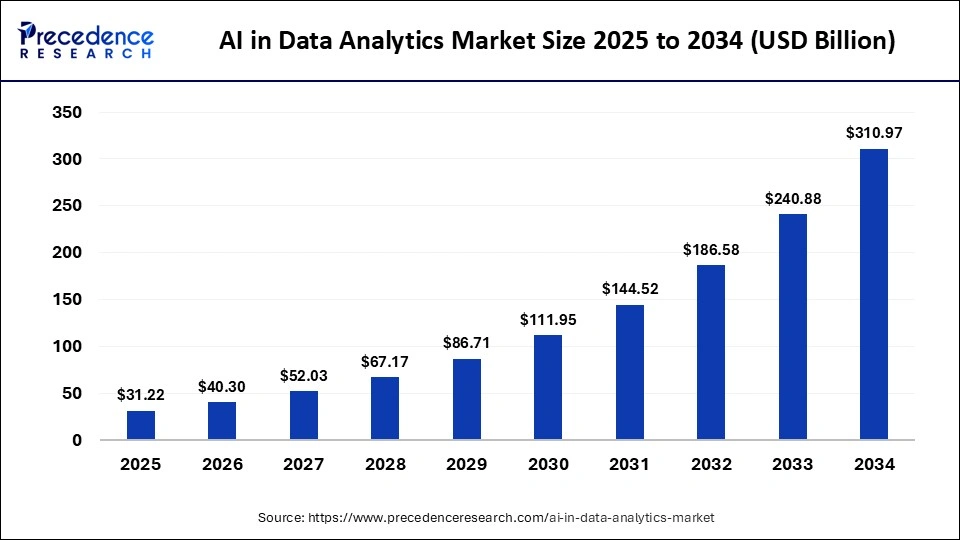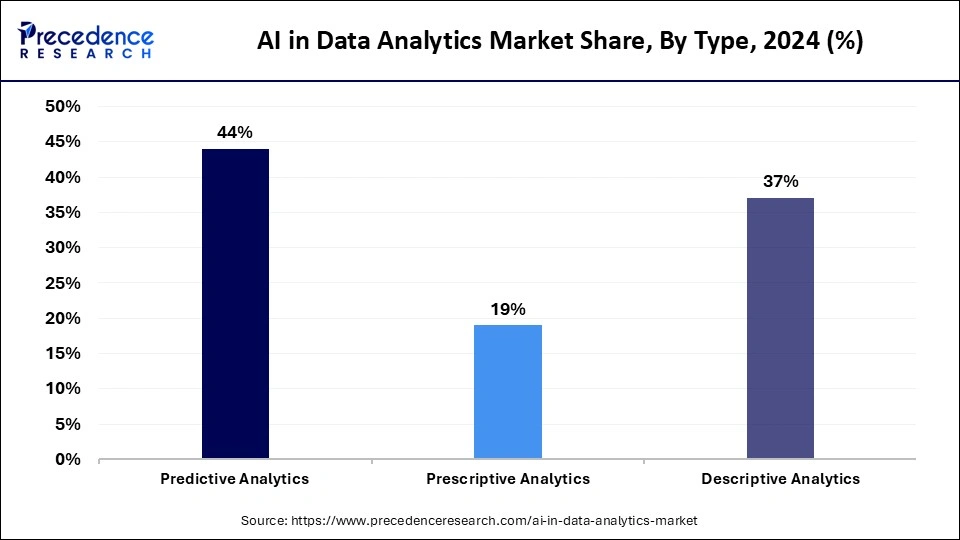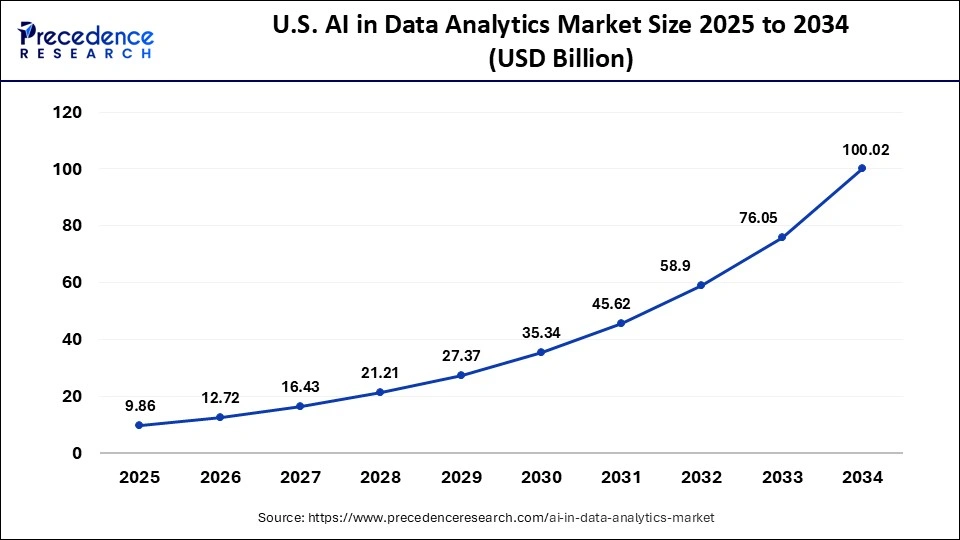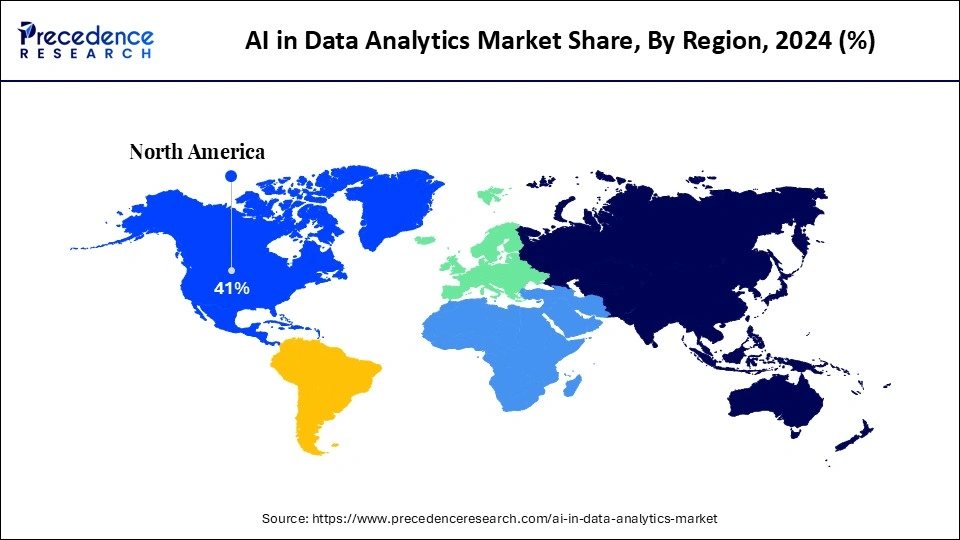List of Contents
What is AI in Data Analytics Market Size?
The global AI in data analytics market size was calculated at USD 31.22 billion in 2025 and is predicted to increase from USD 40.30 billion in 2026 to approximately USD 310.97 billion by 2034, expanding at a CAGR of 29.10% from 2025 to 2034. The growth of the market is primarily driven by the increasing volume of data generated across various sectors through business operations and digital interactions, creating a rising demand for AI-powered data analytics solutions.

Market Highlights
- North America held the largest market share of 41% in 2024.
- Asia Pacific is expected to witness the fastest growth during the foreseeable period of 2025-2034.
- By component, the software segment held the largest market share of 75% in 2024.
- By component, the services segment is expected to witness the fastest growth during the forecast period.
- By type, the predictive analytics segment contributed the major market share of 44% in 2024.
- By type, the descriptive analytics segment is expected to witness the fastest growth during the foreseeable period.
- By industry vertical, the IT and telecommunications segment accounted for the highest market share of 25% in 2024.
- By industry vertical, the BFSI segment is expected to witness the fastest growth during the foreseeable period of 2025-2034.
Market Size and Forecast
- Market Size in 2025: USD 31.22 Billion
- Market Size in 2026: USD 40.30 Billion
- Forecasted Market Size by 2034: USD 310.97 Billion
- CAGR (2025-2034): 29.10%
- Largest Market in 2024: North America
- Fastest Growing Market: Asia Pacific
What is AI in Data Analytics Market?
Artificial Intelligencein the data analytics market involves integrating advanced technologies such as machine learning algorithms, natural language processing, and predictive analytics with traditional data analysis methods. This integration enhances the ability to efficiently process large volumes of data and extract meaningful insights, enabling actionable business decisions and automated processes.
As a result, AI-driven analytics are increasingly being adopted across key sectors, including healthcare, defense, retail, BFSI, and manufacturing. Regionally, North America leads the market due to early adoption of AI technologies, while the Asia Pacific region is experiencing rapid growth driven by expanding digital infrastructure and rising demand for intelligent analytics solutions.
AI in Data Analytics Market Outlook
- Market Growth Overview: The AI in data analytics market is poised for robust growth between 2025 and 2034, driven by its ability to go beyond basic automation to transform business areas and operational models. By 2026, nearly 80% of businesses are expected to adopt models like Generative AI (GenAI) and APIs. This shift enables non-technical users to interact with systems in their local languages through natural language processing (NLP), significantly fueling demand for conversational analytics.
- Demand for Predictive Analytics: Predictive analytics is becoming increasingly vital, particularly in energy-intensive sectors like manufacturing and data centers. By analyzing data usage patterns, AI models can forecast energy consumption and identify inefficiencies or leaks, helping organizations optimize energy usage for future operations. Additionally, AI is being used to predict weather changes and optimize energy grid performance, critical for energy management, renewable integration, and grid stability.
- High Adoption of AI Across Industries: Industries such as finance, healthcare, and BFSI are entering a new era, leveraging real-time data processing, often through IoT sensors, to make faster decisions and enhance customer services. Much of this is powered by custom-built AI solutions designed for specific use cases.
- Global Expansion: As organizations expand their operations across different regions, they generate and access a broader and more diverse set of data. This geographic and cultural diversity enhances the richness, volume, and variety of data available for AI systems to analyze, which in turn improves the accuracy and adaptability of AI models. Major reasons behind the global expansion of AI in the data analytics market are data sovereignty, regulations, and increasing cross-border collaboration. Various regulations like the EU AI Act and the data protection bill by India are encouraging global companies to hold onto their secure data strategies to expand globally.
Key Technological Shifts in the AI in Data Analytics Market
The integration of blockchain technology would be revolutionary for AI in the data analytics market. Its decentralized and immutable ledger system resolves key data integrity and security challenges by ensuring that data used for AI analytics is reliable and free from biases.
The leading sectors, like finance, healthcare, and defense data security, are a priority. Blockchain facilitates secure and transparent data transmission between multiple investors without compromising privacy. This enables AI models to leverage authentic and diverse datasets, leading to highly precise and unbiased outputs. Emerging domains like explainable AI (XAI) are another technological shift in the global market.
Market Scope
| Report Coverage | Details |
| Market Size in 2025 | USD 31.22 Billion |
| Market Size in 2026 | USD 40.30 Billion |
| Market Size by 2034 | USD 310.97 Billion |
| Market Growth Rate from 2025 to 2034 | CAGR of 29.10% |
| Dominating Region | North America |
| Fastest Growing Region | Asia Pacific |
| Base Year | 2025 |
| Forecast Period | 2025 to 2034 |
| Segments Covered | Component,Type,Industry Vertical, and Region |
| Regions Covered | North America, Europe, Asia-Pacific, Latin America, and Middle East & Africa |
Restraint
Incomplete Datasets and Biases
A persistent drawback in the AI in data analytics market is the reliance on poor-quality or incomplete datasets. Missing variables and fragmented data can lead to biased or ethically questionable AI outputs, especially when robust data governance is lacking. As the technology is still evolving, the current lack of comprehensive regulations around data usage creates an unrestrictive environment that may amplify these risks.
However, with increasing government intervention in areas like privacy, data security, and ethical AI usage, this issue is expected to diminish over time. Regulatory frameworks will play a crucial role in ensuring fair, unbiased, and transparent outcomes from AI models.
Opportunity
Empowering Non-Technical Users
A major opportunity in the AI in data analytics market lies in enabling individuals without technical backgrounds to harness the power of AI. Tools powered by Generative AI, such as Tableau, Power BI, and others, now allow users to pose complex data queries in plain language using natural language processing (NLP).
GenAI is also transforming the data workflow by automating repetitive and time-consuming tasks like data cleaning, data transformation, and data visualization. These advancements eliminate the need to write complex code or have deep programming knowledge, making high-quality, data-driven decision-making accessible to users across departments, from finance to marketing. This democratization of AI empowers businesses of all sizes to make smarter, faster decisions without the traditional technical barriers.
Segment Insights
Component Insights
Why Did the Software Segment Dominate the AI in Data Analytics Market?
The software segment dominated the market while holding the largest share in 2024. This is mainly due to the ability of AI software to provide core algorithms and processing power to gain insight from data. It has become highly convenient to use simplified platforms, cloud-based solutions, and the ongoing evolution of AutoML. Software solutions are critical for data analysis, which offers real-time decision-making power across various industries.
The services segment is expected to expand at the fastest CAGR during the foreseeable period. The segment growth is driven by the increasing global demand for digital transformation, particularly the shift to cloud-based services and the growing adoption of technologies like AI and IoT. Also, there is a growing inclination towards remote-work support and on-demand home services, fueling the segment's growth.
Type Insights
What Made Predictive Analytics the Dominant Segment in the AI in Data Analytics Market?
The predictive analytics segment dominated the market with the largest share in 2024. The segment's dominance is attributed to its ability to process vast datasets and uncover hidden patterns, enabling highly accurate forecasts of future trends and behaviors. These insights empower organizations to make proactive, data-driven decisions across a wide range of industries. This shift marks a significant transition from traditional data analysis methods to AI-powered approaches, offering improved speed, precision, and the automation of complex tasks, making predictive analytics a critical driver of AI adoption in data analytics.

The descriptive analytics segment is expected to expand at the fastest CAGR during the foreseeable period. The segment growth is driven by widespread enterprise adoption of robust tools such as sales reports, website traffic summaries, and financial dashboards. These tools are fundamental across virtually all industries, from healthcare and finance to manufacturing, underscoring the increasing demand for clear, real-time insights into past and current performance. As a result, descriptive analytics continues to gain traction as a foundational component of data-driven decision-making.
Industry Vertical Insights
Why Did IT & Telecommunications Segment Hold the Largest Market Share in 2024?
The IT & telecommunications segment held the largest share of the AI in data analytics market in 2024. The segment's dominance is driven by the increasing adoption of AI-powered data analytics for network optimization, predictive maintenance, and enhanced customer experiences. Additionally, the use of AI-driven chatbots helps telecom providers address customer queries in real time while predicting user preferences through behavioral data analysis. These innovations contribute significantly to operational efficiency and improved service delivery, solidifying the sector's leadership in the market.
The BFSI segment is expected to witness the fastest growth during the foreseeable period of 2025-2034. This is mainly due to evolving consumer demands and the convergence of technological innovations, particularly the integration of AI in fintech companies. In addition, favorable economic conditions and strong government policies are accelerating digital transformation across the financial sector. AI-based recommendations are further simplifying business processes by offering personalized suggestions, enhancing customer experiences, and increasing operational efficiency.
Regional Insights
U.S. AI in Data Analytics Market Size and Growth 2025 to 2034
The U.S. AI in data analytics market size was exhibited at USD 9.86 billion in 2025 and is projected to be worth around USD 100.02 billion by 2034, growing at a CAGR of 29.35% from 2025 to 2034.

What Made North America a Dominant Force in the AI in Data Analytics Market?
North America dominated the AI in data analytics market with the largest share in 2024. The region's dominance is attributed to a combination of factors, including significant financial investments by the corporate sector to leverage AI capability, early adoption of cutting-edge technologies like AI, and the presence highly skilled workforce and government-backed policies. In the first quarter of 2025, the region has gained nearly 89.3% of all AI venture capital funding across the world, highlighting their rigorous efforts to build AI-powered ecosystem.
Additionally, North America is home to some of the world's largest and most innovative tech companies, including NVIDIA, Alphabet (Google), Amazon, and Microsoft, as well as a dense network of high-growth startups, particularly in Silicon Valley and Seattle. These tech hubs play a pivotal role in driving AI market growth. World-class research institutions such as MIT and Stanford University also contribute by advancing AI research and supporting commercialization, particularly in sectors like healthcare and finance, further accelerating regional growth.
U.S. Market Trends
The U.S. is at the forefront of technological advancement in AI integration, which is reflected in the high adoption rate of generative AI by major U.S. tech leaders. Deep learning, a foundational AI technology, plays a critical role in this expansion, enabling the analysis of massive and complex datasets with high accuracy.
A key trend driving this growth is automation, particularly in data preparation and model selection. These processes are increasingly being handled autonomously, reducing the need for human intervention and accelerating the overall data analytics workflow. As a result, AI in data analytics has seen widespread adoption across the U.S. economy, driving innovation and operational efficiency across sectors.

Why is Asia Pacific Exponentially Growing in the AI in Data Analytics Market?
Asia Pacific is expected to witness the fastest growth during the foreseeable period. The regional market growth is driven by strong government support for AI adoption in key sectors and widespread digital transformation across industries. Governments across the region are actively promoting AI through funding initiatives, national strategies, and significant investments in research and development. These efforts create a favorable environment for innovation and adoption.
Industries are evolving by integrating cutting-edge technologies to improve operational efficiency, enhance decision-making with data-driven insights, and develop new business models. Additionally, continuous advancements in machine learning (ML), natural language processing (NLP), and other AI technologies enable more sophisticated and diverse applications of AI across sectors.
China Market Trends
There is a rapid development of urban areas with smart home technologies, the expansion of AI-powered manufacturing, and the growing focus on sustainability analytics. The market benefits from strong government support, driven by national priorities and a strategic emphasis on technological advancement. This commitment aims to ensure China remains a global leader in tech-based services and product innovation in the coming years.
Value Chain Analysis of the AI in Data Analytics Market
Data Collection and Integration
This initial stage involves scraping raw data from various sources using web scraping and other data acquisition methods. AI automates the data collection process and helps generate high-quality training datasets by cleaning and organizing the raw data for further use.
Key players: Scale AI, Appen, Labelbox, Qlik
Data Storage and Processing
At this stage, the collected data is properly stored and processed before being analyzed by AI models. This involves building data warehouses and data lakes to manage and store diverse data types efficiently.
Key players: Microsoft Azure, AWS, Google Cloud, Databricks, Snowflake, Cloudera
Insight Delivery and Visualization
This final stage focuses on visualizing data and delivering actionable insights to end-users in an easy-to-understand format, enabling data-driven decision-making to grow businesses. Visualization tools such as Power BI and Tableau are commonly used here.
Key players: Microsoft, Salesforce, Tableau, Power BI
Top Companies Operating in the AI in Data Analytics Market & their Offerings
Tier I – Major Players (~40–50% of Total Market Share)
These are the dominant companies that individually hold significant shares of the AI in data analytics market and collectively account for nearly half of the total market revenue.
- Microsoft: Microsoft leads the market with its Azure cloud platform, integrating advanced AI and machine learning services that enable businesses to build scalable, intelligent data analytics solutions. Its tools like Power BI also empower users to visualize and derive insights from complex datasets easily.
- Google (Alphabet): Google, through its Google Cloud Platform, offers powerful AI and data analytics services such as BigQuery and AutoML, facilitating fast processing of large datasets and automating model building for businesses across industries. Its cutting-edge research in AI continually advances analytics capabilities worldwide
- Amazon Web Services (AWS): AWS dominates with a broad suite of AI and machine learning services, including SageMaker, which simplifies building, training, and deploying machine learning models at scale. AWS's extensive infrastructure supports robust data storage, processing, and real-time analytics for diverse applications
- IBM: IBM leverages its AI platform Watson to provide enterprise-grade data analytics solutions, focusing on natural language processing, predictive analytics, and automation. IBM's strong presence in regulated industries like healthcare and finance helps organizations turn complex data into actionable insights.
- Salesforce: Salesforce integrates AI into its customer relationship management (CRM) platform via Einstein Analytics, enabling businesses to gain predictive insights, automate workflows, and personalize customer experiences. This drives data-driven decision-making across sales, marketing, and service operations.
Tier II – Mid-Level Contributors (~30–35% of Market Share)
These companies have a strong presence with specialized AI and data analytics solutions, collectively contributing around 30–35% of the market.
- Oracle: Oracle provides comprehensive cloud-based AI and analytics platforms that integrate data management, machine learning, and real-time analytics for enterprise-scale decision-making
- SAP: SAP combines AI-powered analytics with its enterprise resource planning (ERP) systems to help businesses optimize operations and gain actionable insights from vast amounts of transactional data.
- SAS Institute:SAS Institute offers advanced analytics software with strong AI and machine learning capabilities, focusing on predictive modeling and data management for complex business problems.
- Alteryx: Alteryx delivers a user-friendly data analytics platform that automates data preparation, blending, and advanced analytics, empowering business analysts to make faster data-driven decisions without heavy coding.
- Databricks: Databricks provides a unified analytics platform built on Apache Spark, enabling collaborative data engineering, machine learning, and AI-driven analytics at scale.
- Snowflake: Snowflake offers a cloud data platform that simplifies data warehousing and enables seamless data sharing, supporting AI-driven analytics through scalable and performant data storage.
- Qlik: Qlik specializes in data visualization and augmented analytics, using AI-driven insights to help users explore and interpret complex datasets for better decision-making.
Tier III – Niche and Regional Players (~15–20% of Market Share)
These companies typically focus on niche applications, industries, or regions, and while individually smaller, together they hold about 15–20% of the market.
- Cloudera
- DataRobot
- Tableau (now part of Salesforce)
- TIBCO Software
- Sisense
- ThoughtSpot
- Smaller startups and local firms
Recent Developments
- In October 2025, Microsoft and LSEG introduced the next step in their multilayer partnership by transforming access to LSEG-licensed financial data, which fuels the deployment of agentic AI with secured data. Through this partnership, LSEG data can enable agents in the Microsoft Copilot Studio.(Source: https://news.microsoft.com)
- In October 2025, IBM, a leading tech enterprise, prioritized a data-first approach to create a robust and governed data ecosystem that powers AI models. The company has unveiled “AgentOps” to help manage AI agent-generated metadata and comply with governance.
Expert Analysis
The AI in data analytics market stands at a critical inflection point, poised for unprecedented expansion driven by the convergence of advanced machine learning architectures, exponential data proliferation, and transformative digitalization initiatives across industries. The evolving landscape underscores a paradigm shift from traditional descriptive analytics towards predictive and prescriptive modalities, enabling enterprises to derive actionable intelligence at unprecedented velocity and granularity.
Key growth vectors are anchored in the democratization of AI capabilities, notably through generative AI and low-code/no-code platforms, which lower the barriers to entry for non-technical stakeholders, thereby amplifying the market's addressable audience. This catalyzes a profound opportunity to embed AI-driven decision intelligence deeply within organizational workflows, accelerating innovation cycles and operational efficiencies.
Furthermore, the intensifying emphasis on real-time analytics fueled by IoT integrations and edge computing paradigms presents fertile ground for AI models optimized for high-velocity data streams. Industry verticals such as BFSI, healthcare, telecommunications, and manufacturing are spearheading adoption, leveraging AI to enhance risk management, personalizing consumer engagement, and streamline predictive maintenance.
Geographically, the Asia Pacific region emerges as a strategic growth frontier, buoyed by proactive governmental policies, burgeoning digital infrastructure investments, and a rapidly expanding talent pool. Simultaneously, stringent regulatory frameworks in North America and Europe are shaping responsible AI adoption, creating opportunities for solution providers specializing in compliance-centric analytics.
Notwithstanding challenges related to data quality, ethical AI governance, and integration complexities, the market's trajectory is unequivocally positive. The persistent infusion of venture capital and strategic M&A activity underscores robust investor confidence. Ultimately, the AI in data analytics market represents a compelling frontier where technological innovation intersects with strategic business imperatives, promising significant value creation for stakeholders who adeptly navigate its complexities.
Segments Covered in the Report
By Component
- Software
- Services
By Type
- Predictive Analytics
- Prescriptive Analytics
- Descriptive Analytics
By Industry Vertical
- IT & Telecommunications
- BFSI
- Healthcare & Life Sciences
- Manufacturing
- Retail & E-commerce
- Government & Public Sector
- Other Industry Verticals
By Region
- North America
- Europe
- Asia-Pacific
- Latin America
- Middle East & Africa
For inquiries regarding discounts, bulk purchases, or customization requests, please contact us at sales@precedenceresearch.com
Frequently Asked Questions
Ask For Sample
No cookie-cutter, only authentic analysis – take the 1st step to become a Precedence Research client